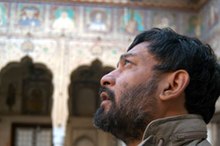Ace Clicker
I’ve known the Indian photographer Pablo
Bartholomew since the 1980s, when he accompanied me and a troupe of (mostly)
French Michelin-starred chefs on our post-publication (of The Official Foodie Handbook) tour of India. Our lot included Pierre
Troisgros, Michel Rostang, Alain Dutournier, Jean-André Charial, Jean Lameloise
and journalists Gilles Pudlowski, Fay Maschler, Gael Greene and Craig
Claiborne. But when this crew got to Goa, the local English-language newspaper
heralded our arrival with the headline: “Ace Clicker in Town.”
That, of
course, was Pablo, then the best-known photographer in the subcontinent.
Pablo Bartholomew
Pablo, who has shown his work at the Photographers Gallery, London (1982), Museum of Modern Art, Oxford (1982), in Arles, New York, Delhi and most recently in 2010 at the Whitechapel, received the 1985 World Press Picture of the year for his iconic picture of the Bhopal Gas Tragedy. We worked together for The Observer in the early 90s, when I was doing a series on regional Indian food. We happened to be together for a shoot in Calcutta on 23 April 1992, when the filmmaker Satyajit Ray died. A crowd of a million – yes, a million – stretched from the place where the body was lying in state all the way to the burning ghat. I dutifully informed the editor that I was in Calcutta and he asked if he should send a photographer. I was able to say that I was already with the best one in the country.
Pablo proposed that we should make our way to where the body was. I was astonished – how were we going to get through the crowds? He asked: “do you have an Observer press card?” I had only my Observer SmartCard, used for buying lunch at the staff canteen, but it had my photograph, and doubled as a security pass at our office. “Perfect,” said Pablo, “show it to the policemen here.” And indeed, we were escorted through the one million to the bier, where Pablo startled me by photographing the body and the grieving family. (“Don’t worry,” he said, “I know/ was at school with/are family friends” or whatever.) We made the front page – but I have to make an admission. I was too lazy or frightened to push our way backwards through the crowds to the ghat, and watched the cremation on live television from my hotel room.
Aged only 19, Pablo won the World Press Photo Award for his 1975 series on Morphine Addicts in India. He is now having a splendid all black-&-white exhibition at a new venue in the East End of London called Fishbar. Though he is known for his documentary photographs of the less comfortable aspects of Indian life, and specially for his work with tribal people, Pablo is here showing what he called (to me) his “teen-aged diary,” photographs of himself and his circle of friends mooching, smooching, smoking, dancing and being decorative, along with some of the photographs taken by his artist, critic and writer father, Richard (1926-85). Richard Bartholomew was Burmese, and escaped during WWII by walking the General Stilwell Road from Mandalay to Ledo in Upper Assam. (It sounds a great deal more romantic than it was, as I know from tales told by my own stepfather, who was stationed with the US Army on the India-Burma border.)
Pablo’s photographs are printed on a very thin material and mounted flush to the wall in an installation in the back room of the gallery. The effect is disconcertingly pleasing – though it has the commercial drawback that you can’t buy the work and take it home with you. Unlike a few of his father’s really stunning small, conventionally framed photographs of his family, friends and larger social circle. I am knocked out by the c. 1962 portrait of the painter, the late M.F. Husain entitled “Old Delhi”. (Richard wrote a monograph on him published by Harry Abrams in 1972.) This show deserves a wide audience. Pablo is now collecting his father’s work in the many forms in which Richard worked. Judging by the Fishbar show, the result will be exciting.



Leave a Reply